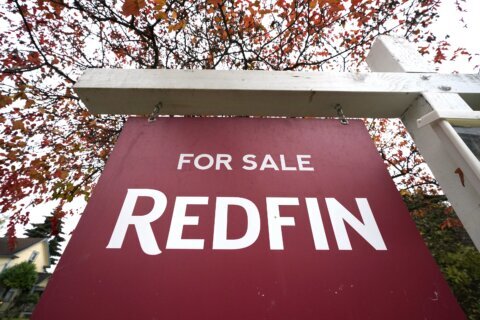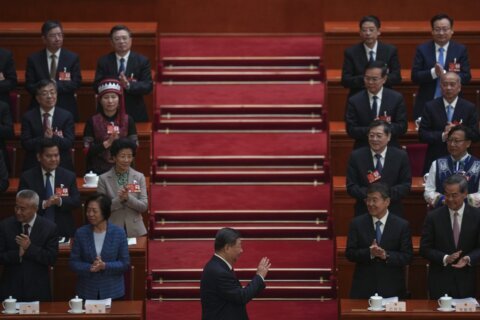BALTIMORE (AP) — Growing up in the streets of east Baltimore surrounded by poverty and gun violence, two kids named Antonio became fast friends. Both called “Tone,” they were similarly charismatic and ambitious, with a shared dream of leaving behind the struggles that defined their childhoods.
One has. The other never will.
Antonio Lee was shot and killed last summer. In the weeks that followed, his friend Antonio Moore warned their peers about the consequences of retaliation, trying to prevent more needless bloodshed and stolen futures in a city that consistently ranks among the nation’s most violent.
“This s— will keep going for the next 20 years, or it’ll stop,” Moore said at Lee’s funeral service in August. “Y’all gotta make a choice.”
Moore, 24, is a successful real estate investor and entrepreneur. He founded a consulting company that helps brands and nonprofits connect with urban youth.
Moore said Lee was committed to forging a similar path; he just didn’t have enough time to see it through.
How was Moore able to break the negative cycles of his youth while Lee fell victim to them?
There are no simple answers, but their disparate fates highlight the sometimes insurmountable challenges facing young Black men from Baltimore’s poorest neighborhoods and similar communities across the country, where rampant gun violence often draws an arbitrary line between life and death.
And the hurdles don’t stop there: underperforming schools, limited job opportunities, inadequate public transportation, inaccessible health care, housing insecurity and an embattled criminal justice system that disproportionately locks up people of color. Guns and drugs are readily available. Hope is hard to come by.
On the afternoon of his death, Lee was washing windshields at a busy northeast Baltimore intersection when gunfire broke out. His loved ones believe he was killed over a dispute between rival groups from different sections of east Baltimore. No arrests have been made in the case. Lee died about four months before his 20th birthday. A second victim survived his injuries.
Stories like this are painfully common in Baltimore even as the city’s homicide rate overall trends downward.
Lee spent his youth in forgotten communities suffering from decades of population loss and unchecked drug activity. He attended Baltimore’s underfunded public schools. Money was tight at home.
He came from a loving family, but his childhood was punctuated by tragedy. A brother was shot to death in North Carolina and a sister died from brain cancer. Several of his closest friends were killed as teenagers.
Lee mourned them all, and he was acutely aware of the potential danger he faced. That’s one reason he was fighting to get out.
Statistically, he was fighting a losing battle. Black children grow up in some of the country’s poorest households. Compared to their white counterparts, research shows they’re significantly less likely to achieve upward economic mobility: About three-quarters of Black children born in the lowest income bracket will remain there for the rest of their lives. They’re also about five times more likely to die in gunfire.
Lee talked about moving to Atlanta or maybe Florida, somewhere he would feel safer. He just needed to save up enough money.
He was constantly brainstorming potential business opportunities — everything from music production to trash collection.
He started working at McDonald’s and considered taking culinary classes. He loved to cook and bake. His funeral program listed some of his favorite dishes: pasta, chicken wings, banana pudding.
Lee was enrolled in one of Baltimore’s flagship anti-violence programs through the nonprofit Roca, which provides mentoring, job training, GED classes and other services. He last spoke to his mentor just hours before the shooting, answering the phone with his signature greeting, an enthusiastic “Hey baby!”
While Lee’s death added to already devastating statistics, Moore is living proof of what happens when the pendulum swings the other way.
Moore grew up in the same struggling neighborhood and underperforming public schools. He basically stopped attending class junior year and his transcripts were abysmal, but he still graduated from high school thanks to a grade-changing scheme that led to districtwide policy changes.
As a teen, he spent most days gambling and selling weed, occasionally dodging gunfire. He was making decent money in the streets, and it was familiar.
But ultimately, the risks seemed to outweigh the rewards. Moore started wondering about the world outside his neighborhood.
He got a job at Chipotle, where he learned how to operate in a corporate setting and talk to customers. One day, he struck up a conversation with a man who worked in Baltimore’s wholesale real estate market.
“Hit me up when you’re ready to make real money,” Moore remembers the man telling him. So he did.
Moore quit Chipotle after about a year. By then, he was supporting himself as a property wholesaler, coordinating deals between buyers and sellers. Moore said his most important asset was his knowledge of Baltimore’s neighborhoods, crime trends, local politics and other factors that could inform investment decisions. The city’s glut of vacant rowhouses provided ample opportunity.
Meanwhile, Moore also launched a consulting firm in 2021, and advises businesses and nonprofits on how to connect with a Gen Z audience. His current client list includes YouTube and the national anti-violence organization Everytown for Gun Safety.
Lee considered Moore a role model of sorts. The pair developed a close friendship based on shared experiences and similar goals. They talked about Lee’s future: how he dreamed of finding a lucrative career and buying his mom a house. Moore offered advice and support. He thought Lee was next in line for success.
Moore was visiting Chicago when he heard about the shooting. He rushed back to Baltimore, unable to shake the feeling that somehow he’d failed his little brother.
“I’m so mad he got killed because kids younger than him would have been influenced and inspired by him, too,” Moore said. “It possibly could have helped change a whole generation.”
Copyright © 2025 The Associated Press. All rights reserved. This material may not be published, broadcast, written or redistributed.









